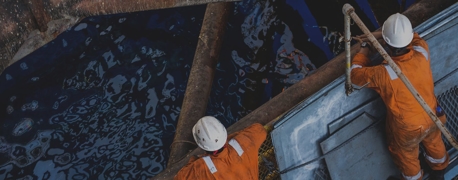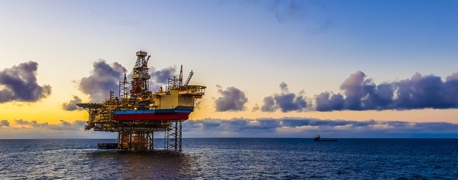Storm Tracker: 5 Agencies That Play a Role in Oil Rig Evacuations (And What They Do)

Oil rigs are among the most regulated offshore vessels, but that wasn’t always the case. Recent disasters, including hurricanes and unprecedented explosions, have impacted the rules that workers on oil rigs—and the companies that operate them—must follow. One of the recent disasters that heavily influenced these rules was the Deepwater Asgard tragedy. This avoidable catastrophe occurred because Transocean blatantly disregarded warnings and recommendations that they received from the agencies in charge of monitoring and maintaining the safe operation of oil rigs, despite the fact that they were in the direct path of Hurricane Zeta and despite the fact that the crew wanted to unlatch the vessel and move to safety.
Before the Deepwater Asgard was the Deepwater Horizon, the oil rig disaster behind the famous BP oil spill of 2010. Both rigs were owned and operated by Transocean, and both were caused by human error decisions while in the path of a hurricane. Although the Deepwater Asgard disaster did not cause any deaths, unlike the Deepwater Horizon, both incidents had a heavy impact on the lives of those aboard and on regulations in the oil industry.
How the Deepwater Horizon Changed Oil Rig Regulations
The tragic Deepwater Horizon explosion in 2010 killed 11 people and led to one of the largest and most damaging oil spills in the history of offshore drilling. Before the well was capped, approximately 134 million gallons of oil had spilled into the Gulf of Mexico. This inspired dramatic reform of offshore oil and gas regulation and oversight.
In the wake of the explosion and oil spill. The House of Representatives passed the SPILL Act in 2010, which aimed to reform marine liability laws like the Death on the High Seas Act of 1920, the Jones Act of 1920, and the Limitation of Liability Act of 1851. The goal of these reformed laws was to ensure that the families of those killed in the Deepwater Horizon explosion—and those affected by future disasters—would be sufficiently and justly compensated.
That same year, the House passed:
- The Consolidated Land, Energy, and Aquatic Resources (CLEAR) Act, and
- The Offshore Oil and Gas Worker Whistleblower Protection Act
Together, these strengthened the oversight of offshore oil drilling, held BP responsible for the cleanup, and implemented strong safety measures. The CLEAR Act also ensured that oil companies pay their fair share for drilling on public lands.
The U.S. government also reorganized its regulatory agencies and created a new one: the Bureau of Safety and Environmental Enforcement (BSEE). In this blog, we will take a closer look at the BSEE and other agencies that play a role in the regulation and safekeeping of oil rigs and their crews, especially when they are in the paths of hurricanes.
Bureau of Safety & Environmental Enforcement (BSEE)
Created in 2011 to regulate the offshore energy industry in swift response to the Deepwater Horizon disaster, the BSEE has a mission “to promote safety, protect the environment, and conserve resources offshore through vigorous regulatory oversight and enforcement.”
In the wake of the Deepwater Asgard disaster in 2020, the BSEE published an investigation report in mid-2021 that outlined their findings. It concluded that the rig damage was caused by the mistaken decision to weather the storm in place while still latched to the well, a mistake that paired inaccurate weather forecasts with serious human error. The report also stated that as a result, Beacon Offshore Energy (BOE), the company that had contracted Deepwater Asgard, updated their Hurricane Evacuation Plan to include upkeep and inspections for barriers ahead of a storm.
The BSEE has since mandated that rig owners issue a "T-time", a report on how much time will be required to evacuate personnel before a storm hits. Also, rig owners in the Gulf of Mexico must now send updates on the progress of shutting down operations and moving the rig.
The BSEE is made up of six national programs that set its policy and performance goals:
- Office of Offshore Regulatory Programs
- Oil Spill Preparedness Program
- Environmental Compliance Program
- National Investigations Program
- National Enforcement Program
- Office of Administration
Most notably, the Oil Spill Preparedness Program, administered by the Oil Spill Preparedness Division (OSPD), oversees plans for and response to offshore oil spills.
BSEE Recommendations
BSEE Safety Alert 415 was published alongside the Deepwater Asgard investigation report. It outlines the challenges and dangers caused by inadequate preparation ahead of a storm, offering recommendations to help operators and contractors avoid them.
The BSEE issued other reports that are to be applied in any instance of an offshore oil rig that faces a storm. BSEE Safety Alert 363 stresses the importance of ensuring that all personnel know the proper protocol for weathering a storm, such as staying indoors.
This was in response to two people not taking the weather threat seriously enough. A roughneck and another member of personnel had stepped outside onto a weather-restricted platform to film the storm on a phone. Due to the violent weather conditions, the person who was filming ended up with a lacerated head and with shoulder and back injuries, but because of the bad weather, had to endure 59 hours onboard before he could be safely evacuated.
BSEE Safety Alert 401 was issued as hurricane season ramped up as a recommendation to:
- Review all emergency plans ahead of hurricane season
- Inspect all gear and machinery for readiness to safely stop operations as needed
- Ensure all equipment and logistics are in place for prompt evacuations
- Have managers make sure that their personnel understand how to safely shelter in place if needed, and that they understand the importance of following such protocols
BSEE Law Enforcement
This agency can enforce violations of the Outer Continental Shelf Lands Act, often in the form of fines that be levied at up to $52,646 per day per violation. Before 2023, the fines used to be $48,862 per day, as can be seen in the link below.
In the past few years, these violations that led to five- and six-figure fines for oil rigs have included:
- An explosion caused by inadequate compressor installation
- A crane boom falling
- Flash fire and injury caused by fuel gas being piped into the air supply
- Advanced corrosion of the structure
Mind you, this is for civil infractions. If criminal activity is uncovered, the case would be sent to the Department of the Interior's Office of Inspector General.
National Oceanic & Atmospheric Administration (NOAA)
Established in 1970 with the merging of 3 agencies dating back as far as 1807, NOAA operates with the goal of better understanding our natural world and helping to protect its resources. Its mission of predicting maritime climate and weather changes and conserving marine resources directly connects to the agency’s involvement in the regulation of oil rigs. (While the NOAA can levy fines for violated regulations, its ability to enforce these penalties is more often seen on fishing operations and actions that involve endangered species, not offshore oil rigs.)
The NOAA does play an integral role in safe and effective cleanup efforts. Even spills on shore can have a negative impact on oceanic and coastal ecosystems. NOAA experts evaluate and regulate best practices for the preservation of these habitats long before–and long after–disaster strikes. The NOAA uses advanced equipment and chemical cleaners to clean up pollutant and oil spills on shore, and they use chemical dispersion, burning, and skimming to clean up oil spills at sea. They also use software to predict the spread of pollutants to better contain an emergency.
One of the divisions of the NOAA is the National Hurricane Center, which is more directly involved in the weather forecasting that affects offshore oil operations.
National Hurricane Center (NHC)
A division of the NOAA, the NHC was founded in 1955 with the responsibility to track and predict tropical storms such as hurricanes. From its headquarters in Miami, FL, the NHC aims to “save lives, mitigate property loss, and improve economic efficiency" through its environmental and weather prediction services. The historical data this agency has gathered as well as its accurate forecasts play an important role in the preparedness of oil rigs in the path of tropical storms and hurricanes.
DTN & WeatherOps
DTN has its finger in a lot of pies, providing insights and data for a wide range of industries, such as:
- Agriculture
- Aviation
- Marine and offshore
- Refined fuels
- Sports and safety
- Shipping
- Transportation
- Utilities and renewable energy
As for its involvement in marine and offshore operations, DTN is the parent company of WeatherOps®. This is DTN's platform for data on maritime and coastal weather, giving subscribers information in real time. According to its website, it can provide up to 10 days' notice on tropical storm developments as well as access to meteorologists. As WeatherOps provides weather information anywhere on the globe, it can provide actionable weather decision support for offshore and port operations.
Incidentally, WeatherOps was the service that provided Transocean with data it ignored leading up to the storm that caused more than $5 million in damage to the Deepwater Asgard.
Now DTN is not a government agency but a private company. As such, it doesn't have any ability to enforce regulations or penalize companies who ignore its data and recommendations.
StormGeo
Founded in 1997, StormGeo was started by a handful of "weather-loving entrepreneurs" and is now a several-hundred person company, one of the largest privately held weather forecasting providers in the world. Since its start in Bergen, Norway, StormGeo has expanded to many offices worldwide, including offices in Houston and Silicon Valley. The corporation primarily offers its 24/7 services to the offshore sector as well as renewable energy, shipping, and corporate enterprise.
StormGeo’s data is used to help oil companies make decisions about the status of the oil rigs they operate, including when and how to prepare and/or evacuate for a hurricane. Again, while StormGeo is not an enforcement agency, it provides an incredibly helpful service to oil companies, with the responsibility falling on the oil company and managers themselves to make the right call based off the information.
Who Is Responsible for Oil Rig Safety?
While several government and private agencies each regulate or support different aspects of oil rig safety, both for the workers and for the environment, it’s the responsibility of the oil companies to follow the rules and recommendations. These companies must prioritize safety over profits. While the decision to halt operations in order to evacuate for a storm can be a multi-million dollar decision, not a small price by any means, the cost of delaying an evacuation and the proper capping of a well can be detrimental to the environment and even put lives at risk, an incalculable amount of damage and loss. However, with good weather forecasting—and a proper response from oil companies—these catastrophes are preventable.


